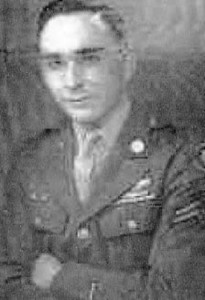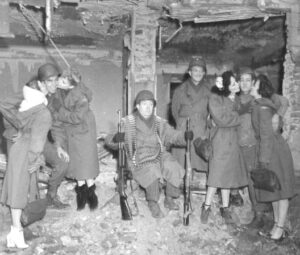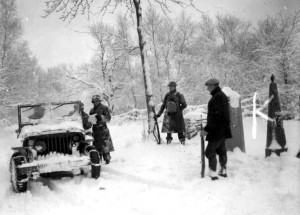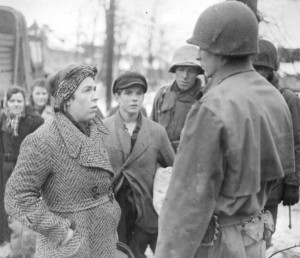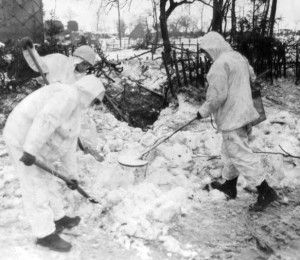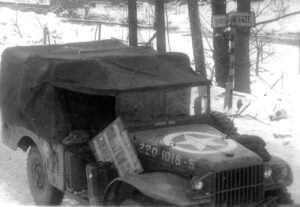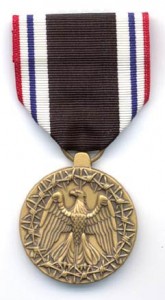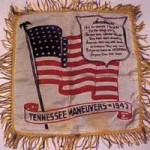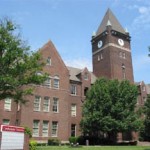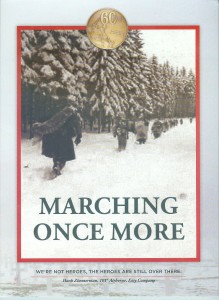In 1943, the Swett family was living at 301 So. Spring Ave., La Grange, Illinois. I was 17 and graduated from LTHS in June. While a senior I had taken the A-12/V-12 “IQ” tests and passed, so was accepted into the ASTRP program to study engineering. I and friend classmate Ralph Leavitt were sent in August to the U of Wis, Madison. We were not yet 18, so were in the reserves, wearing the ROTC uniforms with blue collars. Until the next term started in Sept. we did physical exercises and marched in close order drill. Ralph and I were room mates in Kronsage Hall, along with a tall thin fellow from Centralia, 111., Bill Williams.
We marched to our first class in the morning, but were mostly on our own after arriving in the academic area. Saturdays were workdays but Sunday we were free until supper time when we were expected to show at the dining room for cold cuts, cheese, crackers and bread. After supper it was back to the books. At least once, Ralph and I went to a Congregational Church which was just south of campus. We may have made Sunday services more than once, but we were not regular attenders.
There were several other 1943 LTHS graduates in the Navy V-12 program. They were billeted not far from us and we bumped into them infrequently. Several of our high school buddies visited us one weekend, but other than these intermissions, we were very busy studying. We were told that we were taking almost twice the course load of a normal student in normal times. On weekends the student union showed foreign films. When I could I would attend these. Thinking back on these days, we did work hard but we had moments of fun and relaxation. After a few days of classes we started to sing as we marched to our first class – nothing fancy – “I’ve been working on the railroad”, “You are my Sunshine”, etc. We were in a beautiful spot next to Lake Mendota, and the campus with its hill(s) offered interesting and beneficial hiking. Madison was a good place to be with so much of the world on fire.
At the end of this first quarter, Ralph and I had both become 18, but as Bill was still 17, we had to say good-bye to him. We all went home for Christmas. After Christmas Ralph and I went to Ft. Sheridan where we took additional aptitude tests and both were assigned to the Infantry school in Ft. Benning, GA. We were told that because we were so swift, we would be taking a 13 week basic course in 10 weeks. Looking back on the history of these times, I wonder if they put us through basic in a hurry as they were planning for an invasion back up.
Ralph and I were assigned to different training companies so I didn’t see him again until our next move. On one of my first mornings at Ft. Benning I was detailed to start a morning fire in our barracks. They must have known that this city boy wouldn’t know anything about starting a wood fire in a furnace so they sent Walter A. Petersen, “Bud”, with me to show me how it was done. Bud, I was to find out later, grew up mostly in the North Woods of Wisconsin and Minnesota, with a brief period during high school years in San Francisco. His mother died when he was quite young (before San Francisco). He was the younger of two brothers with a father that was a prison guard. The San Francisco experience occurred when his father was transferred to Alcatraz. Without a mother, but an older brother. Bud was left many of the household duties, such as cooking and cleaning. His two most active hobbies were guns and cameras, about which he was very knowledgeable. Of course, he showed me how to make a furnace fire, but I was never called upon to do the task again.
Bud had been accepted by the ASTP program and had finished his basic in the group before us, but had been held back as cadre to help train our group. History indicates that the decision to terminate the ASTP program had already been made and therefore no one was being sent to colleges to study engineering. My experience in basic was good – training was hard but what we needed. I became an expert marksman with the M-l, and the machine gun, but with the slight chance we were given with the 45 cal. hand gun, I was not able to hit the broad side of a barn. With the constant exercise and good plentiful food (the breaded fried egg plant was great) I went from a 150 Ib. weakling to a 180 Ib. man of muscle. My speed and strength were tested on the obstacle coarse and along with push-ups and chin-ups of the required number (I think it was 30 each) I won the coveted Expert Infantry Man’s Badge, which increased my monthly pay from $21 to $26. We had a very little snack shop near our parade grounds in the Harmony Church area. It was here I was introduced to the Krispy-Kream donut, which I believe were $.10 for a package of two. I would go to the snack shop on our morning breaks.
In March our training was over and most of us were assigned to the 106th Div. which was still on Tennessee maneuvers. Bud and I were assigned to H Co., 423rd Reg., 3rd Platoon. Ralph was assigned to a rifle Co. in a different Battalion so I was not to see him again but only once or twice in our training with the 106th at Camp Atterbury, Ind. A few days after we landed at the Camp, the regulars came in from weeks on maneuvers, worn out, dirty – most, utterly exhausted. Their ranks had been depleted by many being sent overseas as replacements. They knew most of us were wet behind the ears, but they seemed to tolerate us fairly well.
Bud was assigned as part of a mortar crew (the 3rd Platoon of a Heavy Weapons Co. consists of 81mm mortar squads – the other two fighting platoons consist of30cal. water cooled machine gun squads). Because of my experience as a car owner and shade tree mechanic, I was assigned to the motor pool, driving the 3rd Platoon leaders Jeep. I was to see less of Lt. Thomas than the walking members of our Platoon as he always preferred to march with the troops rather than ride in his Jeep. And I was noted to be a careful driver.
Bud and I would go to Indianapolis on weekend passes, mostly to look at photographic equipment in the camera stores and to enjoy the freedom found outside the camp. Over time I became friendly with the acting company clerk, and found that he could write me a weekend pass that would allow me to go home to La Grange. While the pass was fake with a fictitious officer’s signature, I had no problems with using it until one weekend I was delayed getting back to camp because of a freight train wreck on our track. On this trip I was “lucky” to find a seat (many times on these trips to Chicago, we had to stand – once I went to sleep on the platform between cars) but it was next to a high ranking officer. He could sense that I was disturbed by our delay, so he quieted my fears by saying that we could get off at a special station where a staff car would be waiting to take us to camp. It worked out just as he had said. The entire Company was standing at reveille when the camp adjutant delivered me in his staff car. No one ever questioned my tardiness or my whereabouts. What good fortune.
We trained together as a unit from early April until early October. One 35 mile overnight march was the only physical exertion I was subjected to. We did go down to a state park south of the camp where a high pier had been constructed. We jumped off as if we were abandoning ship. For this exercise we wore full field pack and helmet but no boots. That was good as the boots would have been ruined in the water. I believe no one drowned – at least not in our Company. Another group of replacements was sent out of our units, to be replaced by people from the Air Corps and some fresh from basic training. This occurred in late August or early September. We left for Camp Miles Standish, Mass. in early October so we didn’t have time to fully integrate these new troops.
We left Miles Standish as a Regiment, and on Oct. 17, 1944, we left New York Harbor on the Queen Elizabeth, advertised as the largest and fastest ship afloat. Our trip to Scotland was zigzaggy and took five days. The food was so bad and the chow lines so long that many of us elected not to eat. We had nine soldiers and their gear in each stateroom which would be used for two people in civil peacetime.
The people of Scotland greeted us with open arms. Unfortunately we spent very little time with them as we disembarked from the Queen Elizabeth directly onto trains that took us overnight to Toddington in England. After several days there (my notable remembrance of that place was from my first view of the “Honey Dippers” in action) Bud and I were transferred to the stables behind the country estate of Batsford Park, owned by an official of the Imperial Tobacco Company. Bud was chosen because of his vast knowledge of small arms. He chose me to help him run the armory to which all the Division officers had to turn in their weapons. We had a cozy room on the second floor and slept with the guns. Bud taught me haw to play Parcheesi and I taught him Chess. After a few weeks they opened a small USO type room across the hall from us – even brought in a piano. This gave me the opportunity to play some of the pieces I had memorized over the many years of music lessons. I remember no one else taking the opportunity to use this instrument.
Bud and I were issued permanent passes with the idea we could use them as we wanted to as long as one of us was in residence at the Armory. We honored this concept for a while, each spending much time in Oxford, but as we realized we were getting close to our departure to the continent, we traveled together several times to Oxford. During our several months in England, Bud and I would go to the village dances which occurred almost every evening in the nearby town of Moreton-in-Marsh. Neither of us danced but we were entranced by several beautiful English lasses – my heart flutterer was Dorothy Church, who lived only a block away from the dance hall which stood in the middle of the main street. There was one middle aged English couple that everyone watched as they went through their tango routine. Most of the dance floor was cleared when they came out to dance.
One small incident that occurred at one of these village dances. There was a teenage English male that seemed to be at least slightly drunk. He had the idea it would be good to get Bud or me out in the dark individually. Bud and I suspected that he had some accomplices out there that thought it might be proper to do in an American soldier. Among the English “4-Fs” there was a considerable amount of hostility toward American GIs mainly due to the competition for the limited number of females. Bud and I asked him if he needed assistance and that we would both be glad to help. We went out into the air-raid proof darkness, one on each side of him. We ended up down the street and into a back ally, each of us standing on either side of him at the public urinal. Nothing more happened.
From the huge military vehicle depot, all the drivers in our company were issued new Jeeps, with a new weapons carrier for our motor pool sergeant. Bud and I had returned to Toddington by way of Cheltenham S.P.A. on November 20. After all our equipment was cleaned and organized we left in a convoy for Southhampton on Nov. 30, Bud with the other troups on trucks while I drove my new Jeep solo. When we arrived at the docks on Dec. 1, we loaded the second battalion’s vehicles on LST #344, with the drivers staying with their vehicles. The foot soldiers loaded onto troop carrier ships. For the next nine days the most unusual saga of my military carrier took place. For all intents and purposes I was in the U.S. Navy for those nine days, eating Navy chow which was the best in my two years of Army duty. As a PFC I did have some duties to perform, the only significant one that I remember at this point (2005) was guard duty on deck.
LST 344 arrived outside the harbor of Le Havre sometime early the next morning but the harbor was so crowded the we had to take a position outside, dropping anchor to await our turn at the beach or dockside. Several days later we received instructions to move up into a new position. I was on guard duty with my carbine, standing on the port side watching the weighing of the anchor. As the top of the anchor broke the surface, the last link in the chain broke, and the anchor dropped to the bottom of the English Channel. We changed our position and dropped our stem anchor in order to keep this position. This anchor held for at least a day, maybe more, but the cable gave out with a bang. I was in the fantail mess room when this happened, but I’m sure the sound reverberated so that everyone in the ship heard the report. We held our position in the area of the harbor for several days by running the engines.
The word came down to us that there was a problem with one of the engines so we were returning to Southampton. We did, and transferred all of our vehicles to another LST which had two good engines and two anchors. We left Southampton for the second time and arrived at the beach in La Havre with almost no delay. Our disembarkation and start through France was on Dec. 9, 1944.
The trip to Division location was uneventful. We stayed overnight in a French forest. There was snow on the ground. Rather than try to clear a space for my sleeping bag on the ground, I elected to sleep sitting up in the Jeep – passenger side, I recall. Waking up fairly stiff, we were back in convoy on our way to the environs of St. Vith, which is where 106th Division headquarters was located. Breakfast had been a “K” ration — cold. We arrived in Bom either late morning or early afternoon, Dec. 10.
Because the 2nd Battalion, 423rd vehicles had been delayed crossing the Channel, they had put the entire Battalion in reserve, stationed mostly in Bom. I was assigned to a two story house which seemed to be fairly new. We had a number of “H” Co. troops on the second floor, none of which I can now remember so they couldn’t have been from our 3rd Platoon – no close buddies. Bud Petersen had arrived with the foot soldiers eight or nine days before us with the troop transport 2-1/2 ton trucks. He was well settled in a farm house that was closer in toward the center of town. He had already made friends with the family that owned the house, attached barn, and livestock. He was able to get some fresh eggs and was living quite well with only minimal reliance on our Company kitchen. The “old” man of the farm had a short wave radio which was also at Bud’s service. Obviously I spent most of my free time at Bud’s place, only retiming to my billet way after dark. We were located in what was called a non-strategic area, with not much chance of combat action this close to the end of the war. We were warned that there had been encountered some German patrols in the area and that we should be careful of crossing them. I remember trudging through the snow on my way home from Bud’s place, with only a dim light and my carbine held by both hands at the ready. I don’t believe any of the civilians living on the first floor of my house were awake on my return. There were one or two of the fellows in our second floor dorm who had not yet drifted off, so lights were still on.
All went smoothly back in the reserve area. I don’t remember the field kitchen meals. They were regular but evidently not spectacular. Two facts kept us alert. Nightly the V-l rockets would go overhead on their way to England. Early on we would shoot at them with small arms fire as they seemed to be traveling at a low altitude. This was officially stopped as we were needlessly using up ammunition with no apparent affect on the V-ls. The other thing that concerned everyone (we were to learn much later, even our top officers were worried) there was noise from the movement of heavy equipment on the German side of the Ardennes. This was noticeable in the daytime but was particularly worrisome at night when it continued and was almost the only sound that could be heard. We learned later that our Division officers were told that being new to the war we were just unnecessarily jumpy. It would soon be reveled to all what had been going on in Germany.
At 5:30 on Dec. 16,1944, we were awakened by a distant rumbling and the word that we must be on our way at once as the enemy was shelling our lines with the possibility of a ground attack coming soon. I remember thinking that I would dress warmly but leave the remainder of my equipment in my duffle bag in the sleeping room on the second floor of our billeting home as we would probably be back by evening. What a mistake. I never saw any of my personal items or clothing again. The greatest loss was my Waltham watch given to me as a graduation present from High School and the silver dollar with my mother’s birth date, 1890, given to me by Dad just before I left for the service.
Our convoy stopped in St. Vith before proceeding to the front – possibly to receive detailed (?) orders. After much starting and stopping going basically east, we ended up well east of Schonberg and near Bleiauf pulling in between an artillery battalion and the Germans at a very late time in the night. Our mission was to hold off the enemy until the artillery people could extract their pieces and move them toward the rear. Research would probably give me this units name but at that time all we knew was that it’s personnel was black (negro) and that we had a job to do. It was after midnight before all but one 155mm were removed. The one piece not removed was too mired in the mud to get out.
The remainder of that night and much of the next two and one half days and two nights is a blur in my memory, with some notable events standing out but I am unable to place them in a firm order. The problem of retaining precise memories is at least partly due to the weather – it was constantly raining, sleeting or snowing with always low visibility — probably less than a quarter of a mile. There was no sun to guide us and we lowly privates had no compasses. We were instructed who to follow in a convoy, or given instructions for short one or two road trips. Some of the events I do remember were: The road from “Purple Heart Comers” to Auw was along a ridge and open on the side facing the enemy. It was down hill and open on the German side and open fields. On our side (still in Germany) also went down hill but there was the cover of a forest only a few hundred feet below the ridge. Our motor pool sergeant Jacob Antonovich thought we should be down near the trees in what turned out to be a very soft muddy field. All of our vehicles had to be winched out of the mud. Sarg’s weapons carrier may have been the only one that moved out on its own power. It was a good thing that we didn’t have an emergency evacuation.
Another exciting event took place on what road I don’t remember, but we were in convoy, stop and go, when a plane flew over strafing the vehicles. I was right behind a truck carrying ammunition which must have been hit as it started to smoke. Both vehicles in front and back of me were very close, leaving no room to turn around or turn onto the shoulder. My thought was to remove myself from the scene of a gigantic explosion. I jumped out of my Jeep and hopped on a six wheeled armored truck going in the opposite direction. It took me back to our Company H. The truck never exploded and I still feel it was Lloyd Diehl who retrieved my Jeep for me.
When we were together as a platoon in the forest and near the Engineer’s Cutoff, several German prisoners were brought to our area. They had been separated and one was being interrogated, so we had a good chance to observe the one we were guarding. He appeared to be very young, perhaps 14 or 15 years old. He had a deep vertical slice in his back, perhaps 12 inches long and down to his rib cage. He had been given a cigarette and seemed to be unconcerned about his condition. Probably he was in a state of shock. He had evidently been treated by a medic as the wound seemed clean and free of fresh blood. These were events that I saw first hand, I heard many other stories from buddies that were very interesting, but I do not intend to include in this bio. any events that I can not verify by my own observations.
The sharpest memory still with me after all these years (I am now almost 82, and this all took place over 60 years ago) are the events that took place on the evening of December 18, and the day of the 19th, the day we were surrendered. As it was getting dark, we received orders to form up our vehicles on the Engineer Cutoff to attempt a run down the Bleiauf/Schonberg road in order to make a breakthrough to the 3rd Battalion, giving us a better chance to fight our way through the encirclement and work our way back through Schonberg and hopefully, back to St. Vim. All 2nd Battalion vehicles were lined up ready to go as darkness fell. As it was almost pitch black we shoved off to drive as fast as we could down the enemy held road. At comers many of our captured field pieces were pointing down the road directly at us. I must have been near the front of the line, as nearly as I made out my jeep wasn’t hit by enemy or friendly fire. Ken Smith claimed to be riding on my ammunition trailer, but was thrown off on a comer before we reached 3rd Battalion on a hill just outside Schonberg. I was stopped by 3rd Battalion personnel and told to dump my jeep in the river as the Germans were on the low side of the road and occupied Schonberg. After detaching my trailer which had some 81mm mortar ammunition in it, I drove to the right and down to the river, and as best I could determine in the dark, dropped off the bank and buried the radiator in the river bank. After doing this I was told that the Germans held the river also.
Going back up the hill I fell into a large hole. I went down so suddenly that I fell out from underneath my helmet. For what seemed like many minuets, I felt around for it. I could not locate it, so climbed out of the hole and went up the hill and laid down. It was drizzling, cold and damp. I hadn’t slept in three nights so didn’t much care where I slept or under what conditions. This was a deeply forested area. The shells from the German 88’s were exploding in the trees above us. I got some sleep this night but several stray pieces of shrapnel from the 88’s hit my face and hands (wrist), caused some bleeding of surface wounds, but didn’t cause me to lose much sleep. I was bone tiered and didn’t much care at that point if the enemy got a direct hit on me.
The next morning, December 19, we had no meal (most of us hadn’t eaten since dinner on Dec. 15) but went to work defending our hill. I soon discovered that only two of our Battalion vehicles made it through the intense fire on the German held Bleiaulf 7Schonberg road on the previous evening. The other vehicle was an “H” company headquarters jeep driven by Ramey Boetcher. Days, months and years later I learned many of the stories of the demise of the other unfortunate vehicles, how they were shot up, went off the road, missed turns and some were captured. God must have had future plans for me as he guided me safely down that road.
I spent the morning hauling 81mm mortar rounds up the hill from my trailer to the one 3rd Battalion mortar which had been set up in a clearing over the crest of the hill. During the day, someone noticed my lack of helmet and gave me one that had a bullet hole right through the side. I was told its previous owner had no further use for it. As I was carrying mortar shells up and over the hill, there was a tall lean fellow digging himself a foxhole just to the right of my path and near the forward side of the hill. When he finished his hole he got into it and nothing could pry him loose. As I passed him for more than an hour as he was digging. (Years later at a Division reunion I was telling this story to other members of”H” Co, 423rd, and Ramey admitted he had been the one who had dug his hole and wouldn’t be moved out. He said, “I was going to stay out of the way of those 88’s”)
At approximately 3:30PM, we were out of ammunition, had been for some time. A loud speaker came up from the base of the hill, and a voice with no trace of German accent said, “Your officers have surrendered you. Come down off the hill and form up on the road.” This was repeated a number of times and the lack of firing of any kind (very quiet) indicated this was probably the end of the war for the 3rd Battalion. (Later we were to learn that it wasn’t only the 3rd Battalion, 423rd, that had been surrendered, but our commanding officers Col. George L Descheneaux of the 422nd, and Col. Charles C. Cavender of the 423rd, had indeed surrendered our two regiments.) When the truth of the situation sunk in, I had the immediate job of taking my hand weapons apart and throwing their parts as far as I could into the forest. I could see troops already forming up on the road as I came down the hill.
As I came onto the Bleialf/Schonberg Road, I noticed a headless GI lying in the ditch. His body was the shape and size of one of our husky privates. Later I learned our husky private had survived and was in fine shape. Ramey’s jeep was still sitting in the middle of the road and Sgt. Webb was sitting upright in the back seat, dead. The motor was still running. Soldiers I didn’t know, brought a badly wounded fellow dragging between them. They set him on the far side of the ditch, gave him a cigarette, he took several puffs and died. We were surrendered to an SS troop, and while nothing was said, many of us recently free soldiers may have had some worries as to how they would treat us. Evidently, the German officer in charge knew or felt the war was almost over, or perhaps he was one of the few SS officers who was more humane than what we had been led to believe, we will never know which, but we were not treated badly. His troops lined us up on the road and after a half hour or so, we were marched the six or eight miles to Bleialf. It was just getting dark when we arrived in Bleialf. We slept in the church yard that night (Dec. 19). I still had my heavy GI overcoat, but it was cold and damp and as we had no food for several days and little or no sleep since Dec. 16,1 was all set up for one of my winter colds.
On the morning of Dec. 20, we were lined up on the road opposite to the one on which we had arrived the previous evening, ready for the 25-30 mile march to Gerolstein. Still no food. By this time Bud Petersen and I had been reunited and we marched together on our way to the rail junction at Gerolstein. Four or five miles from the start of our march we entered to city of Prum. Other than the central church, every other building had been reduced to rubble. For me it was a very depressing sight. This was really the first physical affects of war that most of us had witnessed – bricks and stones piled haphazardly and flowing into the street.
We had yet many miles to go, marching until dark, arriving in Gerolstein an hour or so after sunset. I remember little of the details of this march as I had awakened that morning with a raging fever. I kept throwing my coat off, Bud kept picking it up and putting it back on me or carried it himself. This probably was a life saver for me. I will always feel I owe Bud more than I can ever repay. We slept on the soiled ground at the bottom of a sheep shed that night. We did have a roof over our heads, however. Still no food.
The next morning (Dec 21) they say we had some thing to eat, maybe so but I have no memory of what it might have been. Sometime during the morning we boarded a string of 40/8 boxcars. These are small cars and it was very possible we had more than forty prisoners on each car. We had a can to use as a latrine and an open window (very small covered with barbed wire) to facilitate the release of deposits. The can was used very little – nothing going in so nothing coming out. We had received no food or liquids for days.
Our train’s progress was very intermittent – stop and go. We never knew where we were at any time but learned much later (mostly after we returned home) some of the high points of this trip. We were in the same boxcar from the morning of Dec. 21, until the morning of Dec.25, never being let out or offered food or drink. We tried to sleep but there wasn’t enough room for all of us to sit down, much less all lie down at once. The biggest excitement to occur on this short-distance-long-time trip happened in the Koblenz rail yard the night of Dec. 23/24. British Mosquito light bombers bombed the rail yard extensively. One soldier in a nearby car was shouting at the top of his lungs to God for deliverance. I shouted back that God could hear us without shouting. Several cars were hit with some injuries and deaths, but our car wasn’t touched. The rail yard just to the east of us in Limberg must have been the British main target that night as their casualty rate was much higher and the tracks were so disrupted we never saw the prison camp there to which the Germans originally intended for our train load.
Sometime early in the morning of Dec. 25, Christmas Day, before daylight, our train stopped. We had arrived in Bad Orb. As soon as their was any light from the dawn, we could see a few scattered German officers standing and walking on the platform. They were dressed in natty uniforms all in light pastel colors. At this time we didn’t know where we were. As soon as it was fully light, we were let out of our boxcars and lined up in a nearby street in columns of four. The Germans soon had us organized and we were marched up the town’s main street, up the hill, approximately one and one half miles, to our new home, Stamlager IX-B, or for short, Stalag IX-B. We were the first Americans to arrive at this camp.
INTERNMENT: Much has been written about These German POW camps so I will only include the high points as I was impressed. This memoir was started in another century, and it is now (2010 AD) 65 years since these events took place.
The camp was not too full upon our arrival. It had been used to house combatants that were not fully covered by the rules of the Geneva Convention. There were Russians and other Eastern Europeans soldiers as well as French underground fighters. The French seemed to be in charge of the kitchens which turned out to be not a great benefit to us Americans. After a few weeks this was changed and we took over our own kitchen. Our daily diet consisted of a cup of ersatz coffee in the morning, a piece of bread along with some margarine (sometimes) with a ladle of very weak soup for lunch, and some kind of tea for supper. I weighed 180 Ibs. going into the camp. Three and one/half months later I was down to 105 Ibs. In our last month and one/half, we received four Red Cross boxes. Each box was distributed to so many inmates (the first went to 11, the second to 13, the last two to 5 and 6) that they were not noticeable in staving off starvation. These individual boxes were sized for one person, or two at the most.
Our (Bud Petersen and I) first barracks was quite large with two large rooms on either end for sleeping in triple bunks, and a wash room with a cold water tap in the buildings center. Each large sleeping room had a hole in the floor for nighttime toilet use. During the day we were to use a large pit outdoors which had an A frame built over it with horizontal poles running down each side. If you had to defecate you would back up to one of these poles so you were sitting over the pit. This was all open air, no sides, no floor, no roof. Fortunately with not much in the way of solids going in, this pit got little else but urine.
After three or four weeks, with more prisoners coming in (Americans, British, South Africans, Australians) our squad, including Bud and I, were moved to a smaller barracks which had no bunks, so we slept on the floor. We shared blankets so that we could have one under us and one over. The blankets were never cleaned and as we never received a clean change of clothes or had no shower for at least three months, we lived in a total condition of filth and stink. I found that my personal biggest problem was the growing colony of lice in my pants and underwear. When this problem became unbearable we would take off our clothes and search out the little critters, ending our misery by popping the guts out of them. That must have ended their misery also.
The division of the bread each day was a special ritual. We had eight or nine in our squad and either Walter A. (Bud) Petersen volunteered to be the bread cutter (squad leader) or we elected him. Every day he cut the bread into equal(?) portions and he was the last to have a choice, – he took what was left. No one ever questioned his work as he did such a fine job. On his grave stone in northern Wisconsin is engraved, “He cut the bread fair and square”. There was not much to occupy our time, and as bread was the only solid food we received each day. Bud had the most important job in the squad.
I had a piece of sheet steel about seven inches long that I had sharpened on a stone. This was my knife and after I received my bread I would spend at least an hour, generally more time than this, to cut my bread into minute pieces. Then I would spend almost as much time eating the pieces one by one. Other time occupiers for me was reading. I must have read the New Testament at least twice and a history of the de Medici family by some English author. This book was loaned to us by some English suppliers to the Red Cross. The book was informative but very poorly written and boring. As our energy levels continued to fail, there was less that we wanted to do and less that we could. The Germans early on tried to give us small tasks but even they became undoable as our abilities ebbed.
There were three or four substantial stone buildings just down the slope from our main gate. Bud and I were given the job of carrying arm loads of wood down to these units which were being used to house wounded German soldiers being rehabilitated. Between loads, Bud and I stood side by side between two of these buildings, looking down into the woods below us. We had no guards with us. We discussed the possibility of escaping into the forest. Our tracks in the snow would have been a great path for our captures. We decided it would be a worthless endeavor, – a bad idea.
Later in our stay, we were told that there was a real chance that we would be bombed by our own air force, and that we should help in digging bomb shelters. By this time I was so weak that I couldn’t lift the shovel from the bottom of the hole to its top edge. Our guards soon gave up on this project. The only brutality that I witnessed happened soon after we arrived at Bad Orb. I think it happened the day after our arrival. Dec. 26, 1944. Upon being interrogated those of us who refused to give anything other than our name, rank and serial number (all that we should have been required according to the Geneva Convention) a group of 40 to50 of us were stood at attention outside in the snow without coats or hats. One of our group who had been injured in his hand, put the bandaged hand inside his shirt front in an effort to suspend it and keep it warm. A guard saw that this wounded soldier was strictly not at attention, so in walking past he grabbed the soldier’s hand ,• pulled it out and hit it with the handle of his pistol. Some in that group of Americans said we stood out there in the cold three hours. I think it may have been more like one hour. There were penalties meted out for infractions of the rules but nothing that seemed unfair.
Conversations revolved about food. When you are starving you don’t think of anything other than eating. I was able to save a small address book in which I recorded important events as they happened, and FOOD. I have a list of every candy bar that anyone could think of, some that I had never heard of. It also included favorite recopies. The southerners in our group, and we had many, invariably included peanuts in their favorites.
Some couldn’t give up smoking. It was more important to some than food. These folks would trade food, money, anything for smokes. Of course most of these people died of malnutrition a month or two after arriving in the camp. Cigarettes eventually became the camps monetary medium of exchange, each cigarette being valued as $5.00, and $5.00 was worth then what is worth $20.00 or more today (2010 AD).
Easter came on April 1, 1945, April fools day. Early on April 2, a light armored contingent from Patton’s Third Army, “broke down the front gate”, representing our liberation. I was too weak to go out and welcome them. Our liberators brought us plenty of food, but the wrong kind – too rich. Those of us who could eat the new rations developed diarrhea, and were soon back on our old prison diet. The Red Cross brought in one of their donut trailers. One of our number who thought he had a cast iron stomach went over to the trailer and reportedly ate a dozen. He died shortly thereafter. Why would the RC allow him to eat all those donuts? I was too weak to make it over to the RC trailer.
Before liberation, George Thompson was enjoying the spring weather and laid down on a slope to contemplate his world. George developed a grand case of pneumonia and Bud and I placed him between us on the barracks floor so we could keep him covered during the night. This worked out (not very well) for only two or three nights and then George was taken to our dispensary, which was staffed by several medics, Don Candy, a neighbor from LaGrange being one, and perhaps an American doctor. Anyway, George died on April 1, 1945. We had his funeral on April 4, with Bud and I leading the honor guard. A movie of this funeral procession and the grave side burial was taken by some officer and I have a grainy copy of it. I still can’t reason how I had enough energy to walk the quarter mile out to the cemetery and back. By this time reporters from the “Stars & Stripes” and other publications were swarming over the camp so Bud and I had numerous photos all over the world.
After almost a week after liberation, it seemed that transportation would soon be organized to get us out of Stalag IX-B. One morning, about this time, they set up sick call and several members of our squad thought! should go and find out the source of my constant cough. So I did – walking pneumonia. That same morning I was taken to a nearby air field and transported by C-47 to a field near Camp Lucky Strike in northern coastal France. I was at once placed in the camp hospital for “rest and rehabilitation”. The food was wonderful. Soon my stomach had adapted to steaks and other great American treats. After a month in this hospital, during which time FDR died, I was offered a pass to Paris, but was told I might miss the first ship home if I took it. No sir, I wasn’t going to chance missing that first ship.
The hospital ship was a converted Liberty ship, the SS Marine Devil. We had only approximately half the maximum number of patients the ship had been designed for, so the kitchen was not overworked. I can remember having as many as six custom fried eggs for breakfast, many of the candy bars we had talked about in Bad Orb, and of course, many steaks. It took us two weeks to get from Southhampton to Boston, during which time the war in Europe was officially over. I took a train to Chicago and another one to LaGrange and home to 301 So Spring.
After a very eventful 90 days at home on R&R, I went to Miami Beach for reassignment. That was a pleasant week with not much to do but visit relatives and swim in the hotel (White House) pool. I didn’t yet have enough points to allow me to be discharged (the war with Japan was over by this time) but the reassignment clerk said he would send me anywhere I might want to go, except the Air Force, as there was already way too many people in the AF and they couldn’t let them out fast enough. I chose to go to the Engineers as that profession was what I had decided on and that is what the Army had staifed me on in the ASTP at the U of Wis. They sent me to Ft. Belvoir, the Army Engineers school, which is just outside Washington, DC. I had a varied experience here on the cadre under the direction of a tech sergeant that was old enough to be my father. At this time I had received my second stripe so I expected all the privileges of a noncommissioned officer. However they were short of privates on base, so corporals had to pull KP. But in the two months there, my name never came up for KP duty. I worked with a survey crew laying out the lines for a new drill field, became a projectionist, was taught to instruct in laying booby traps and demolition explosives, as well as making signs advertising my bosses girlfriend who was singing in a Washington club.
I left for home and discharge in late November. My boss took me to the Non-Com club on base and bought me my first drink. I was just 20.
